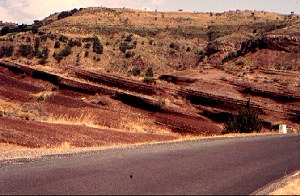Changes on Earth
During the Permian nearly all continents drifted together and at last
they formed one supercontinent, called
Pangea.
This enormous landmass headed slowly for the North in the course of the Permian
. This movement had started earlier but at that time the ocean currents could
still pass unhindered through the Tethys Ocean. When this passage got closed,
a totally new situation developed. The ocean currents then headed for the
north en the south pole.
During the Permian there was sea at the place of the north pole and because
of the warm currents no icecap was formed. The south pole however was situated
on land (Antarctica) and at that place an icecap developed, which expanded
strongly over the southern hemisphere during the Early and Middle
Permian.
An important cause of the climatic change in the Permian was the fact
that the moderating influence of the sea was reduced. The supercontinent
Pangea had an enormous inland and a relatively short coast-line. That's why
the largest part of the world got an extreme continental climate with very
hot summers, very cold winters and intense drought.
During the Late Carboniferous Western Europe was situated in
the equatorial region and the climate was at first warm and humid. The formation
of peat in Northwestern Europe had stopped for the most part at the end of
the Westfalien D as the extended coastal swamps did no longer exist after
the Variscan orogenesis: the former lowlands had been elevated. Only in the
so-called intramontane basins, like the Saar-Nahe basin and some basins in
Central and South France, considerable peat layers were still formed, which
converted later on into coal. In the very beginning of the Permian there
has been also formation of coal at some places in Europe, like Manebach in
Thüringen (Germany) and Autun in France. The name Autunian for the lowest
part of the Permian is derived from this city.
 During the last part of the Autunian the circumstances changed definitely:
a harsh and dangerous time for plant (and animal) began. The red colour of
the sediments indicates a hot and dry climate.
During the last part of the Autunian the circumstances changed definitely:
a harsh and dangerous time for plant (and animal) began. The red colour of
the sediments indicates a hot and dry climate.
Red Permian strata in South France